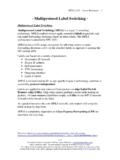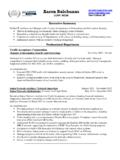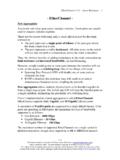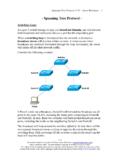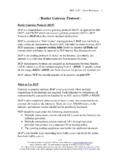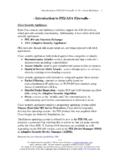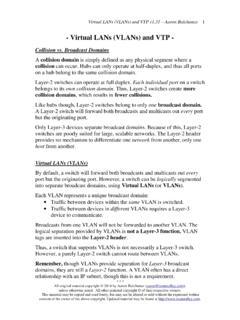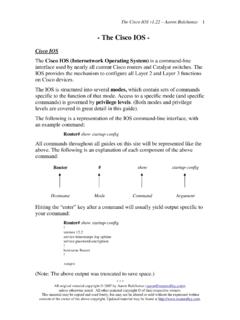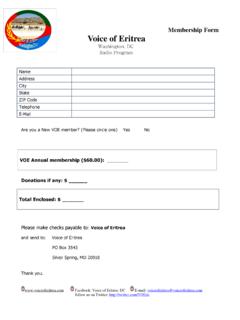Transcription of Basic Voice over IP - Router Alley
1 Basic Voice over IP Aaron Balchunas * * * All original material copyright 2007 by Aaron Balchunas unless otherwise noted. All other material copyright of their respective owners. This material may be copied and used freely, but may not be altered or sold without the expressed written consent of the owner of the above copyright. Updated material may be found at 1 - Basic Voice over IP - Voice over IP (VoIP) Voice over IP (VoIP) is a digital form of transport for Voice transmissions, replacing analog phone systems. The benefits of VoIP are considerable: Better use of bandwidth - Traditional Voice requires a dedicated 64-Kbps circuit for each Voice call, while VoIP calls can use considerably less. Additionally, no bandwidth is consumed when no call is being made. Single form of cabling Reduces implementation and maintenance costs by having a standardized and consolidated cabling and equipment infrastructure. Cost savings from integration into the data network Toll charges for inter-office Voice communication can be avoided by routing Voice traffic across existing data lines.
2 Integration into devices beyond telephones Basic VoIP components can include: Phones including both analog and IP phones. Gateways allows a non-VoIP (analog) device to communicate with the VoIP network, or a VoIP device to communicate with an analog network. Application Servers provides required applications to VoIP phones. Gatekeepers maps phone numbers to IP addresses, and grants permission for call setup Call Agents handles call routing and setup. Digital Signal Processors (DSP s) are used by devices to perform analog-to-digital and digital-to-analog conversions. Both VoIP phones and gateways utilize DSP technology. Basic Voice over IP Aaron Balchunas * * * All original material copyright 2007 by Aaron Balchunas unless otherwise noted. All other material copyright of their respective owners. This material may be copied and used freely, but may not be altered or sold without the expressed written consent of the owner of the above copyright.
3 Updated material may be found at 2 VoIP Packetization Voice traffic must be packetized as it traverses the IP network. Sound is first captured using a microphone on the headset. A Voice call requires a 4 kHz (4000 Hz) channel. To convert analog Voice to a digital format, samples of the frequency and amplitude of the analog wave are made. Thus, sampling merely takes a snapshot of the signal at a given point in time. The amplitude height of each snapshot is assigned a numeric value, through a process called quantization. This numeric value is then represented as a sequence of binary digits (usually 8) through a process called encoding. The Nyquist sampling theorem dictates that the analog wave should be sampled at a rate of twice the channel s frequency range: fs = 2(freq. range) Thus, assuming a range of 4000 Hz, this requires a rate of 8000 samples per second. Remember that each sample is assigned an 8-bit value to represent the amplitude height at the time of sampling.
4 Thus, a dedicated 64,000-bit channel (8-bits x 8000 samples per second) was traditionally required for a Voice call (hence a DS0 being 64 Kbps). The process of encoding an analog signal into digital format is handled by a codec (coder-decoder). The codec usually provides a level of compression. The efficiency of the compression varies with the codec used; however, more compression generally degrades sound quality. Various codecs include: uses 64 Kbps for a Voice call uses 32, 24, or 16 Kbps for a Voice call uses 16 Kbps for a Voice call uses 8 Kbps for a Voice call Generally, the analog sound is chopped into groups of 10ms, and then sampled and encoded. Each group (or often two groups, for a total of 20ms of analog sound) is encapsulated within an IP packet. At the transport layer, Real-Time Protocol (RTP) is used instead of TCP. RTP operates on top of UDP. When the Voice packet arrives at a digital-to-analog gateway, the headers are stripped off, and the sound is reassembled as an analog stream.
5 Basic Voice over IP Aaron Balchunas * * * All original material copyright 2007 by Aaron Balchunas unless otherwise noted. All other material copyright of their respective owners. This material may be copied and used freely, but may not be altered or sold without the expressed written consent of the owner of the above copyright. Updated material may be found at 3 Cisco VoIP Integration Cisco devices operating as VoIP gateways can contain a variety of analog interfaces, including: Foreign Exchange Station (FXS) interface connects to an analog device, providing the appropriate voltage and dial tone. Foreign Exchange Office (FXO) interface connects to a PBX (Private Branch Exchange) or PSTN (Public Switched Telephone network). E&M interface can also be used to connect to a PBX, or is used for PBX-to-PBX connections. Additionally, Cisco gateways can connect to provider PBX s and networks using digital interfaces, including: ISDN BRI and PRI T1/E1 CCS (Common Channel Signaling) employs a dedicated channel for signaling.
6 T1/E1 CAS (Channel Associated Signaling) a portion of each channel is utilized for signaling. Basic Voice over IP Aaron Balchunas * * * All original material copyright 2007 by Aaron Balchunas unless otherwise noted. All other material copyright of their respective owners. This material may be copied and used freely, but may not be altered or sold without the expressed written consent of the owner of the above copyright. Updated material may be found at 4 VoIP Signaling Protocols VoIP protocols are responsible for the three key stages of a Voice call: Call setup Call maintenance Call teardown The most common VoIP protocols are as follows: an ITU standard Session Initiation Protocol (SIP) an IETF standard Media Gateway Control Protocol (MGCP) an IETF standard Skinny Client Control Protocol (SCCP) Cisco proprietary Basic Voice over IP Aaron Balchunas * * * All original material copyright 2007 by Aaron Balchunas unless otherwise noted.
7 All other material copyright of their respective owners. This material may be copied and used freely, but may not be altered or sold without the expressed written consent of the owner of the above copyright. Updated material may be found at 5 Cisco VoIP CallManager Configuration Voice Trunk Ports Traditionally, Cisco IP phones contain a switch with two interfaces. The first interface connects the IP phone to the wall jack. The second interface connects the user s workstation to the IP phone. This allows a single cable to handle the user s Voice and data needs. To keep the Voice /data traffic segregated, the IP phone forms a trunk link with the remote switch. Data traffic is tagged as a different VLAN than the Voice traffic. Configuration on the remote switch (or the call-manager functioning as the switch) is simple: VoIP-Switch(config)# interface FastEthernet0/1/4 VoIP-Switch(config-if)# switchport access vlan 50 VoIP-Switch(config-if)# switchport trunk native vlan 50 VoIP-Switch(config-if)# switchport mode trunk VoIP-Switch(config-if)# switchport Voice vlan 60 In the above example, data traffic will be tagged as VLAN 50, while Voice traffic will be tagged as VLAN 60.
8 Basic Voice over IP Aaron Balchunas * * * All original material copyright 2007 by Aaron Balchunas unless otherwise noted. All other material copyright of their respective owners. This material may be copied and used freely, but may not be altered or sold without the expressed written consent of the owner of the above copyright. Updated material may be found at 6 Cisco VoIP CallManager Configuration Dial Peers Dial Peers provide call-routing, and serve two key functions: VoIP dial-peers - used to connect Cisco call-managers, gateways, or gatekeepers to other such VoIP devices. For example, two call-managers at separate branches would point to each other using VoIP dial-peer commands. POTS dial-peers used to connect Cisco VoIP devices to an analog device or network. A dial-string is mapped to a local analog port on the VoIP gateway or call-manager. Thus, the function of a Dial Peer is to match an incoming call with a destination pattern, which points to either a remote device or local interface.
9 To configure a VoIP dial-peer: CallManager(config)# dial-peer Voice 1 voip CallManager(config-dial-peer)# session procotol sipv2 CallManager(config-dial-peer)# session target ipv4 CallManager(config-dial-peer)# destination-pattern 15865551212 CallManager(config-dial-peer)# codec g711ulaw The above configuration maps a sip connection to a remote VoIP peer at address for phone number 15865551212. The g711 codec is being employed. To configure a POTS dial-peer: CallManager(config)# dial-peer Voice 2 pots CallManager(config-dial-peer)# destination-pattern 1212 CallManager(config-dial-peer)# port 0/2/0 The above configuration maps an extension or phone number of 1212 to the analog Voice port 0/2/0. (Reference: ) Basic Voice over IP Aaron Balchunas * * * All original material copyright 2007 by Aaron Balchunas unless otherwise noted. All other material copyright of their respective owners. This material may be copied and used freely, but may not be altered or sold without the expressed written consent of the owner of the above copyright.
10 Updated material may be found at 7 Cisco VoIP CallManager Configuration Telephony Service Telephony-Service configuration provides a wide variety of global configuration options for a Cisco CallManger: CallManager(config)# telephony-service CallManager(config-telephony-service)# The configuration files for specific models of IP phones are stored in flash, with a .bin extension. To load these configuration files: CallManager(config-telephony-service)# load 7914 S00105000200 CallManager(config-telephony-service)# load 7920 CallManager(config-telephony-service)# load 7960-7940 P00308000400 To specify the maximum number of phones that can register with the Call-Manager (dependent on the hardware/software platform): CallManager(config-telephony-service)# max-ephones 12 To specify the maximum number of directory numbers (DNs) the Call-Manager will support (also dependent on the hardware/software platform): CallManager(config-telephony-service)# max-dn 48 To specify the IP address of the Call-Manager on the Voice VLAN: CallManager(config-telephony-service)# ip source-address port 2000 To specify the extension for voicemail: CallManager(config-telephony-service)# voicemail 2000 To specify the audio file for music-on-hold.

